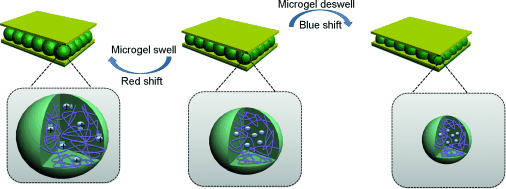Swelling Stacks

“Intelligent” materials that can respond to external stimuli are high on the wish lists of many scientists because of their possible usefulness in various applications from sensors to microrobotics. Canadian researchers are working with polymer-based microgels that can swell and shrink.
In the journal Angewandte Chemie, they introduce tiny, stacked structures of microgels whose optical properties change in response to light, changes in pH value, or temperature. They can also detect nerve gases.
Gels are cross-linked molecules that can hold a liquid within their “loops”, which makes them swell up; microgels are “small” colloidally stable gel particles. The microgels being investigated by Michael J. Serpe and his team at the University of Alberta are swollen at temperatures below 32 °C; at higher temperatures they collapse and shrink.
The researchers used these materials to make small stacked structures called etalons: they enclosed a whisper-thin layer of microgel between two thin layers of gold. When the gel swells up, the two sheets of gold move farther apart, when it shrinks they get closer to each other. The optical properties of the stack change significantly as the distance between the gold layers changes, meaning that they “respond” to a change in temperature.
However, the goal is to make the gels react to other stimuli besides temperature. The researchers thus also incorporated triphenylmethane leucohydroxide (TPL) into their microgels. This substance is a true jack-of-all-trades that makes the microgels receptive to a variety of stimuli.
Now irradiation with red laser light, which is absorbed by the TPL, leads to a local rise in temperature within the microgel, which causes the distance between the gold layers to decrease. In contrast, irradiation with UV light excites the TPL molecules so that they dissociate into leuco cations and hydroxy anions. The charges of these ions cause the microgel to absorb additional water—increasing the distance between the gold layers.
These effects make the microgel stacks interesting for the production of adjustable optical components. Another possible application is for drug delivery with remote triggering: when a diseased area of the body is irradiated with high-wavelength light through the skin, the drug contained in the transporter can be released selectively in only the desired location.
The microgel also reacts to a change in pH value: an acidic pH causes the formation of leuco cations, whose positive charge causes the gel to swell by taking up water. If the pH is raised back up, the microgel shrinks. This could be used for the selective release of antitumor drugs because tumors often have a somewhat different pH value than the surrounding tissue.
Interestingly, organophosphates react with TPL molecules, also forming leuco cations. The resulting swelling of the microgel and changes in the optical properties of the stacks could be used for the quantitative detection of nerve gases like tabun.
About the Author
Dr. Michael J. Serpe is an Assistant Professor in the Department of Chemistry at the University of Alberta. His research is focused on using polymer-based materials for multiple applications; with a particular focus on developing novel point of care diagnostics, water remediation systems, and polymer-based muscles and actuators. He was recently named a Grand Challenges Canada Rising Star in Global Health, received the 2013 Petro Canada Young Innovator Award, and has been named one of Edmonton's Top 40 Under 40 by Avenue Magazine for 2013-2014.
Author: Michael J. Serpe, University of Alberta, Edmonton (Canada), http://www.chem.ualberta.ca/~serpe/Serpe_Group/Serpe_Group_Home.html
Title: Optical Devices Constructed from Multiresponsive Microgels
Angewandte Chemie International Edition, Permalink to the article: http://dx.doi.org/10.1002/anie.201402641
Media Contact
All latest news from the category: Life Sciences and Chemistry
Articles and reports from the Life Sciences and chemistry area deal with applied and basic research into modern biology, chemistry and human medicine.
Valuable information can be found on a range of life sciences fields including bacteriology, biochemistry, bionics, bioinformatics, biophysics, biotechnology, genetics, geobotany, human biology, marine biology, microbiology, molecular biology, cellular biology, zoology, bioinorganic chemistry, microchemistry and environmental chemistry.
Newest articles

Webb captures top of iconic horsehead nebula in unprecedented detail
NASA’s James Webb Space Telescope has captured the sharpest infrared images to date of a zoomed-in portion of one of the most distinctive objects in our skies, the Horsehead Nebula….

Cost-effective, high-capacity, and cyclable lithium-ion battery cathodes
Charge-recharge cycling of lithium-superrich iron oxide, a cost-effective and high-capacity cathode for new-generation lithium-ion batteries, can be greatly improved by doping with readily available mineral elements. The energy capacity and…

Novel genetic plant regeneration approach
…without the application of phytohormones. Researchers develop a novel plant regeneration approach by modulating the expression of genes that control plant cell differentiation. For ages now, plants have been the…





















